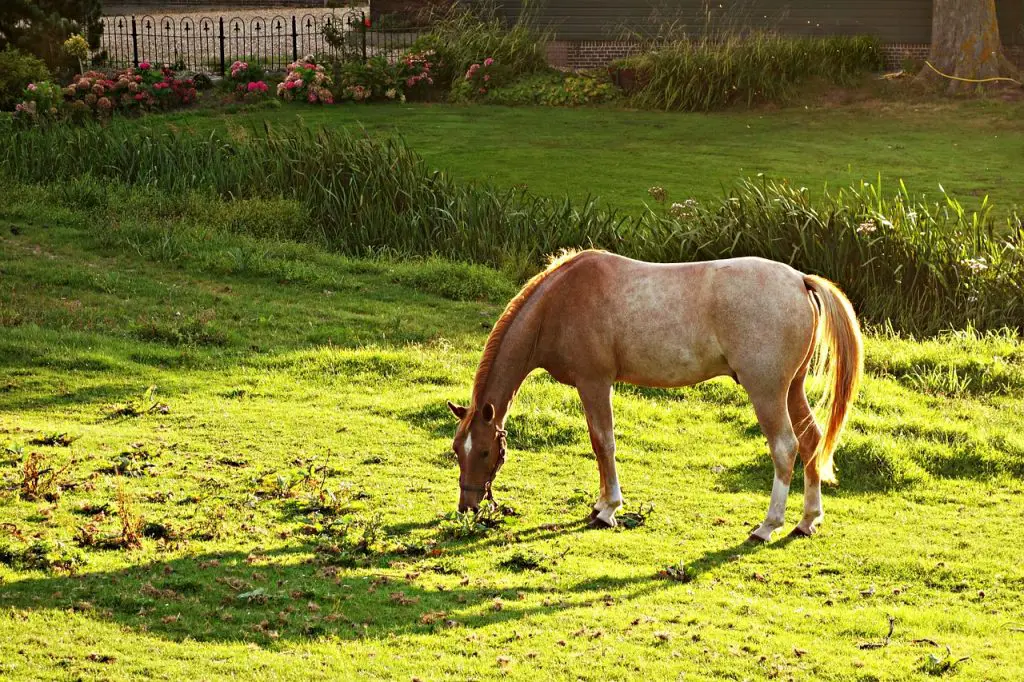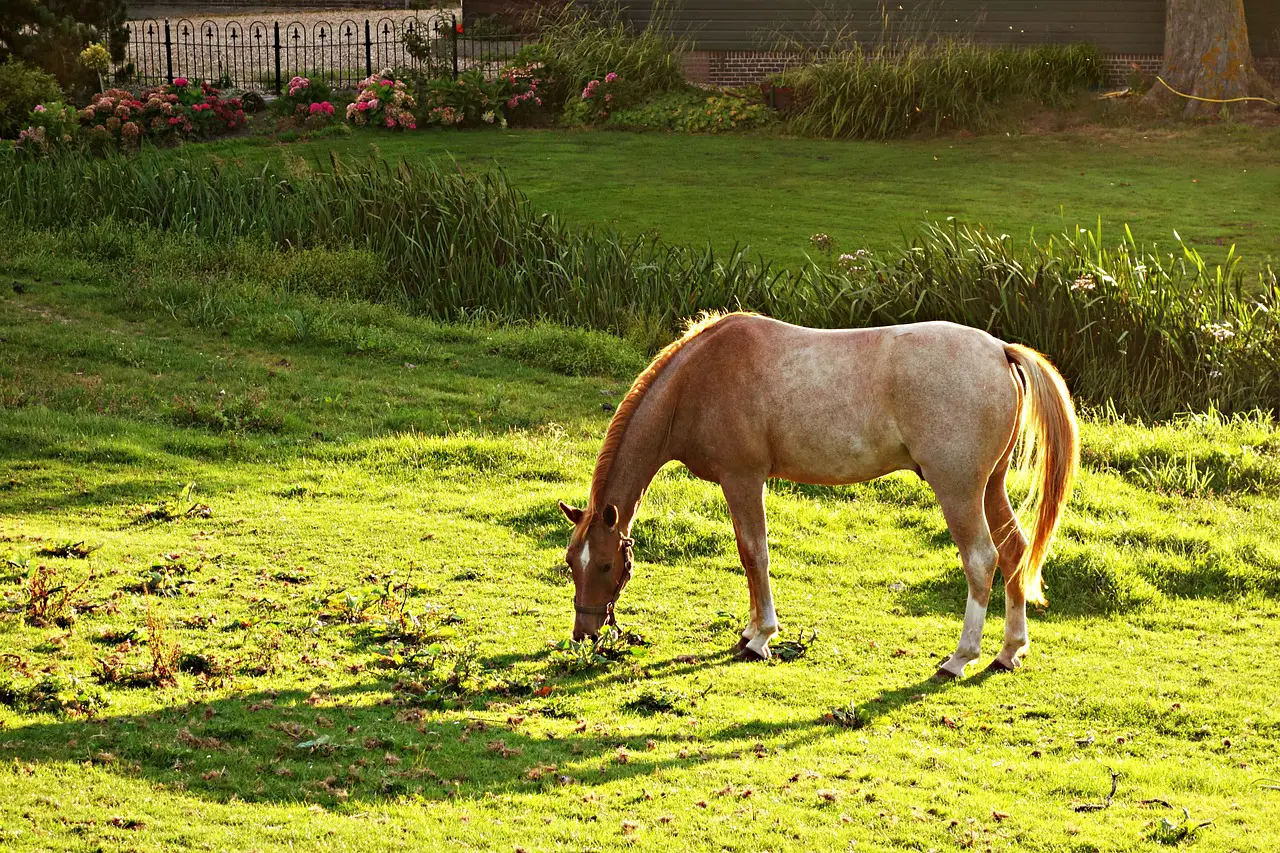Last Updated on February 24, 2022 by Allison Price
Roan horses are stunning and highly sought after in the horse world. Their distinctive coloring appears as though they have been permanently dipped in powdered sugar or snow!
This coloration is instantly recognisable, making it highly desired and sought-after by equestrians all over the globe.
Roans do not belong to a single breed, as some might mistakenly believe.
What is a Roan Horse, you ask?
Roan horses are distinguished by their unique roan hair pattern. This is a blend of colored and white hair. This unique color pattern makes horses’ coats appear lighter than their base color.

The roan horse’s head, and lower leg are often in a solid color. (source)
What is a Classic Roan Pattern and how do you make it?
The classic roan is the most commonly used pattern when referring to a horse as a roan.
Classic roan horses are genetically different to horses with other roan-mimicking styles.
Apart from its genetic differences, the classic roan pattern is visually distinct from other roan designs.
The roan-patterned area is evenly populated with white, unpigmented hairs. The hairs in other roan-like designs are not evenly mixed.
Roan Coat Color Genetics
An autosomal dominant gene confers the classic roan coloration as an inherited trait. It sounds complicated but it’s not as difficult as it appears.
It simply means that the roan gene has been passed down from parents to children and that one copy is required to display the trait. (source)
Horses that inherit the roan genes from at least one parent will display the roan pattern on their coats not. Source
Roan Zygosity Testing
Scientists have not yet discovered the actual genetic mutation, so there is no way to test for it.
To determine if a horse has the roan-zygosity (a sequence of genes known to cause roan color), DNA marker testing can also be performed. It is known as the Roan Zygosity test and costs approximately $40 per test.
For information on DNA testing available for horses, and labs that can do the roan test, be sure to read our article.
If a horse has the double classic roan gene (meaning both parents passed it on to their offspring), then it is more likely that that horse will have roan offspring. Horses that do not inherit the roan gene marker from their parents are unlikely to have roan-colored offspring.
Roan Zygosity Results
These are the only three genetic options for the roan color of a horse according to the UC Davis Veterinary Genetics Lab.
| Result | Explanation | Roan Coloration | Chance of Roan Offspring |
| N/N | Horses do not possess any roan genetic marks. | There is no display of the classic roan color pattern. | Zero |
| N/Rn | Horse inherited 1 copy the roan genetic marker. | A classic roan colour pattern in a stunning display. | Around 50% |
| Rn/Rn | Horse was given 2 copies of the roan gene marker from each parent. | A classic roan colour pattern in a stunning display. | High chance. |
There are many common variations of Classic Roan Colors
All roan horses are bred with the natural colors of the horse and the roan patterns are simply incorporated within them.
Horse registries are most likely to recognize three classic roan varieties. These are the most popular roan patterns.
Red/Strawberry Roan
Red roan refers to roan horses with a thick, chestnut-based coat. Strawberry roan describes lighter-colored horses with a roan pattern.
Horses with solid chestnut colors can have a light-to-dark reddish brown coat that covers their entire body, even their lower legs.
It is important that the Red Roan term was once used to describe bay-colored roan horses. However, bay roans were later given their own category.
Bay Roan
This bay roan American Quarter Horse mare is less expressive than other roans during summer.
Bay roans are horses that have a bay-colored base and exhibit the roan pattern. A solid bay horse will have a reddish-brown to light brown coat similar to a chestnut horse.
The distinctive blackness of the bay horse is what sets it apart from other chestnut horses. Other than bay roans, bay horses have black skin underneath most of their hair, except when it is covered by a white mark on their faces.
Blue Roan
Blue-colored roan horses have a bluish-tinted base coat. Because the horses are bluer than they are gray or black, the roan coloring gives them the name blueroan.
Blue roans may appear solid at first, but their coats can change to the roan patterns if they are born with the roan gene.
Uncommon Roan Colors Variations
Palomino Roan
It is possible to find a palomino-colored horse, although it is rare. Palomino horses have a beautiful golden coat and a white mane or tail.
The color is genetically inherited from a cream dilution gene. This creates a beautiful palomino color.
Buckskin Roan
Buckskin horses are tan-colored with black lower legs and manes.
Buckskin roans will be black with black legs, mane and tails. They also have tan or gold hair that is evenly distributed throughout their bodies. (source)
Dun Roan
Dun roans can be roan-colored horses with a dun color base. They can be red, black, or tan. Dun-colored horses have a lighter, more diluted body with darker shading on their legs and manes.
Their backs have a distinct darker shaded stripe. This distinguishes them from other colors such as bays or horses that look dun-like. (source)
Roan x paint
Paints horses may also be available in a variety of roan colors, including bay, sorrel and chestnut as well as dun, black, palomino, black, dun, and black.
Paint horses with roan colors can have large areas with white and colored areas with the roan pattern. Paints can be solid without white but still have paint horse genetics. (source)
Other Roan-like Patterns
There are some roan-like pattern that can be confused with true roans. This is because they are called Roaning even though these are not traditional roan patterns.
These are some of the most common roan-mimicking styles you might see.
Grulla ‘Roan’
Grulla is also known as grullo and it is a horse colour that belongs to the dun horse family. Grulla horses, like duns, have darker bodies and longer manes.
Blue duns (also known as black-based duns) are also known as grullas roans. They don’t have the same interspersed white hairs as classic roans, but instead have shades of mouse-gray hairs mixed in with their base color.
The shading of a grulla-roan can be silver, blue or black. Technically, they are not roans because they don’t have the classic roan genetic marks.
Rabicano
The rabicano (also known as white ticking) is a roaning style that is easy to identify. Because the interspersed white hairs are not evenly distributed, it is distinct from the traditional roaning pattern. This results in some areas of the horse’s body being whiter than others.
The pattern is also lighter in areas such as the belly and flanks, which extend out to different parts on the horse’s bodies.
A noticeable amount of white ticking can be seen on the horse’s tail at the base, which is often the only sign that the horse is following the rabicano method. (source)
Sabino
The white spots on Sabino-patterned horses are what distinguish them. White markings are characterized by roaning at their edges where white hairs mix with colored hairs.
Horse enthusiasts mistake sabino horses as having true roan genes. It may look just like a regular paint horse if the sabino gene is not fully expressed.
A sabino horse may look very much like a classic roan if it is exponentially expressed. (source)
Varnish
Varnish Roans look similar to a traditional roan, but their color can change over time. Like traditional roans, varnish roans can include areas of solid color as well as white roaning around the horses’ legs and heads. Varnish roan horses will develop whiter hairs as they age.
Also, they are not genetically related with classic roan horses. They are instead a variety of leopard complex patterns found in breeds such as the Appaloosa, Noriker and Knabstrupper horses. (source)
Coat Color Changes
Seasonal
Horses with classic roan patterns may experience slight changes as the seasons change.
They will be back to their normal roan shades in the spring and summer.
Injured areas
The classic roan color will not fade with time. Sometimes, roans’ coats will show signs of wear and tear.
Hair can sometimes grow in a solid color if it is scratched or has a wound that causes hair to fall.
These areas or spots are known as corn marks. These spots can also appear in areas where there was no injury.
Myth of the “Lethal Roan”
If two animals with the same gene have different colorings, it can lead to a deadly or lethal combination.
In the 1970s, researchers mistakenly believed that combining a classic roan horse with another classic roan would create a deadly combination.
They were concerned that the hormone was causing embryos not to develop as early as possible. The Veterinary Genetics Laboratory of UCDavis refutes this idea today and states that it is false. (source)
19 Horse Breeds With Roan Prevalence
Some horse breeds are not capable or know to produce different roan colors. Despite some appearances as roans, the classic roan pattern in Arabians and Thoroughbreds has not been scientifically confirmed. These breeds are likely to have the classic roan patterns.
- Quarter Horse
- Paint Horse
- Mustang Horse
- Tennessee Walking Horse
- Appaloosa Horse
- Half-Arabian
- Shetland Pony
- Gypsy Cobs
- Spanish Mustang
- Icelandic Horse
- Welsh Pony
- Miniature Horse
- Paso Fino
- Peruvian Paso
- Belgian
- Brabant
- Ardennes
- Standardbred
- Trait Du Nord
Last Thoughts
It is obvious that roan horses look great. They are also a popular choice for horse lovers. There are many ways to distinguish between a roaning horse and a traditional roan horse.



